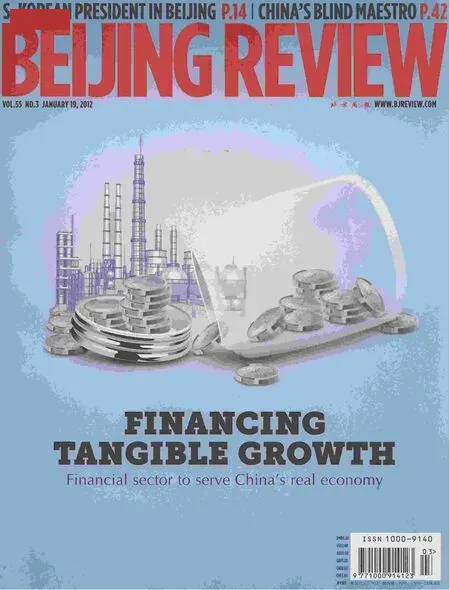MARKET WATCH
MARKET WATCH
OPINION
Export Machine
Many a headline has highlighted how rising costs in China are putting pressure on profit margins and reducing the competitiveness of the country’s huge labor-intensive, exportoriented manufacturing industry.
However, a closer look at trade data shows that China’s overall exports are still gaining market share. In 2011, Chinese exports grew by around 20 percent in U.S. dollar terms and 10 percent in real terms, compared to an increase in real global imports of around 7 percent.
Many multinationals including Nike,Coach and Topform have moved some of their production of garments and sneakers to Viet Nam, other Southeast Asian countries or the Indian subcontinent.
These high-pro fi le cases, however, are not really representative, and it would be a mistake to conclude that they herald the demise of China’s export success. The shift out of China is basically only happening in the production of simple garments and sneakers.
Simple garments and sneakers are among the most low-value-added, labor-intensive sectors, with relatively little need for equipment, infrastructure, supply networks and skills. As China is moving up the value chain,these least attractive and quite mobile sectors are the most obvious ones to go. Indeed, the manufacturing powerhouse of Guangdong Province has at times actively promoted the transfer away of “low value-added and polluting” industries.
Textile, garments and sneakers make up only about 15 percent of China’s total exports.In other export sectors where equipment, infrastructure, supply networks and skills matter more, there has been little or no transfer of production to other countries. Meanwhile, in sectors such as electronics, there is a shift of production within China from its traditional export-oriented manufacturing hubs along the coast to inland regions.
The main reason why the amount of manufacturing production that has left China has been very small is that the wage cost pressures have largely been offset. Gains in ef fi ciency and labor productivity have been rapid. This has meant that, after their impressive fall between 1995 and 2004, increases in unit labor costs (wage costs per unit of product) have been modest and gradual in recent years.
Meanwhile, what is sometimes forgotten is that wages have also risen quite a bit in countries mentioned as alternatives to China,such as Viet Nam and Bangladesh. This is even more so with the higher raw material prices, which are by nature a global phenomenon. Moreover, China’s advantages in infrastructure, clusters of suppliers, and deep labor markets are hard to overlook.
Factoring in the appreciation of the yuan,China’s export prices have risen in U.S. dollar terms in recent years. Data on U.S. import prices are considered to be good because they are adjusted for quality adjustments. And they show that in January 2012, prices of U.S. imports from China were 5 percent higher than two years ago. Thus, China’s export-oriented manufacturers have basically maintained price competitiveness in foreign markets, especially compared to other emerging markets.
What is more, despite the cries of pain of export firms and industry organizations,China’s manufacturers have, overall, maintained their pro fi t margins.
Average pro fi ts as a share of gross output in industry dipped in 2011 after peaking in 2010. But pro fi t margins still compare favorably to the historical experience, suggesting,overall, that exporters have not had to sacrifice margins excessively to maintain price competitiveness. Thus, it is not that surprising that China’s exports are holding up very well in global markets.
THE MARKETS
Job Market Buoyed
In 2011, there was consistent growth in salaries across various industries in China as multinational corporations continued to expand into the country, said a recent report by Robert Walters, a world-leading recruitment consulting fi rm.
Talent shortages coupled with the large number of job vacancies meant that talent retention became a key challenge for numerous organizations.
Jobs advertised in China in the fourth quarter of 2011 shrank by 3 percent from the previous quarter. Nevertheless, Chinese companies are still looking to grow, as demonstrated by a 20-percent increase in job advertisements from the fourth quarter of 2010.
“The outlook in China is cautious yet upbeat as we enter 2012, despite the modest slowdown at the end of last year,” said Carter Yang, Managing Director of Robert Walters China. “Recruitment activity is likely to resume as job churn increases after bonus payouts in the fi rst quarter of 2012.”
Powerful Merger
China’s two largest online video websites Youku and Tudou plan to merge through a stock swap to forge an industry leader in the world’s biggest Internet market.
Youku is listed at the New York Stock Exchange while Tudou issued an initial public offering on the Nasdaq market in August 2011. Once the deal is completed, Tudou will delist its shares.
The new entity, named Youku Tudou Inc.will control more than a third of the country’s online video advertising market, according to the Internet research firm Analysys International.
The merger came as a huge surprise as Youku had in February filed a lawsuit against Tudou, claiming that it suffered losses because Tudou accused it of misusing copyrighted material.
“We expect to see significant synergies across a number of areas including leveraging licensed content over a larger user base and realizing efficiencies in bandwidth management,” said Victor Koo, CEO of Youku.

